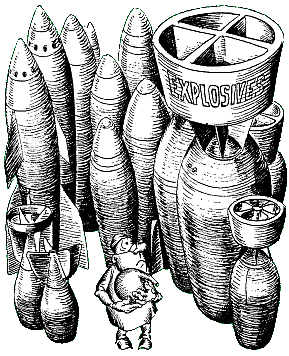107Stories About ChemistryINDEX |
45.
Lightning and Tortoises
An explosion is a terrible thing. It is terrible because the explosion occurs instantly, in a split second. But what is an explosion? It is just an ordinary chemical reaction accompanied by the evolution of a large amount of gases. It exemplifies a chemical process which takes place instantaneously, such as the combustion of gunpowder in a bullet shell or the explosion of dynamite.  But an explosion is a sort of extreme. Most reactions take some length of time to occur. There are many reactions which proceed so slowly that they can hardly be detected. Imagine a mixture of two gases, hydrogen and oxygen, the components of water, in a glass container. They may stand in it for a very long time: a month, a year, a hundred years, without a single drop of moisture being detected on the surface of the glass. One might think the hydrogen is not combining with the oxygen at all, but actually it is, though very slowly. It would take thousands of years for a hardly perceptible quantity of water to form at the bottom of the container. Why is this so? Because of the temperature. At room temperature (15-20�C) hydrogen reacts with oxygen only very slowly. But if we heat the container, its walls begin to sweat. and this is a sure sign that a reaction is occurring. At 550�C the container flies apart in tiny fragments, because at this temperature hydrogen reacts with oxygen eruptively. Why does heat accelerate this chemical process so, making the �tortoise� move like lightning? In the free state hydrogen and oxygen exist as the molecules H2 and O2. To combine into a water molecule they must collide. The more often such collisions take place the greater the probability that a molecule of water will form. At room temperature and ordinary pressure each hydrogen molecule collides with an oxygen molecule more than ten billion times per second. If each collision resulted in chemical interaction, the reaction would proceed faster than an explosion, in the course of one ten-billionth of a second. But we do not observe any change in our container: neither today, nor tomorrow, nor in ten years. Under ordinary conditions only very rare collisions result in chemical reaction. The trouble is that the hydrogen and oxygen collide as molecules. Before they can react they have to break up into atoms. To put it more exactly, the valence bonds between the oxygen atoms and the hydrogen atoms in their molecules must be weakened. They must be weakened to such an extent that they should not be able to prevent the combination of unlike hydrogen and oxygen atoms. Now the temperature is the whip which makes the reaction go faster. It increases the number of collisions many times over. It makes the molecules vibrate more strongly, and this weakens their valence bonds. And when hydrogen and oxygen meet each other at the atomic level, they react instantly. |





